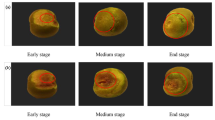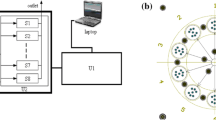Abstract
Non-destructive detection of decay in fruit in real time during cold chain is important to recycle the decayed fruit in time for reverse supply chain. Fruit is commonly stored inside external packages during cold chain, making neither manual observation nor optical inspection techniques available to detect the decay in fruit. In this work, the potential of a self-developed handheld electronic nose (e-nose) instrument to non-destructively acquire volatile substances and then detect decay in peach fruit during cold chain (0 °C) was explored. A desktop e-nose instrument was considered as a comparison. The storage days of peach fruit during storage were also predicted by two instruments. Partial least squares discriminant analysis and least squares support vector machines (LS-SVM) were used for the classification of decay in peach fruit. Partial least squares regression and LS-SVM were used for the prediction of the storage days. Successive projection algorithm (SPA), uninformation variable elimination (UVE), UVE-SPA, and competitive adaptive reweighted sampling were applied to select the characteristic variables from e-nose data. The best model for the classification of decayed fruit during cold chain by the handheld e-nose instrument had the correct answer rate of prediction of 95.83% (94.64% for healthy samples and 100.00% for decayed samples). The best model for predicting the storage days of peach fruit during cold chain by the handheld e-nose instrument had the residual predictive deviation value of 9.283. The results indicate that the self-developed handheld e-nose system is a simple and non-destructive tool to detect decay in peach fruit during cold storage.

Similar content being viewed by others
References
Baietto M, Wilson AD (2015) Electronic-nose applications for fruit identification, ripeness and quality grading. Sensors 15(1):899–931
Besada C, Salvador A, Sdiri S, Gil R, Granell A (2013) A combination of physiological and chemometrics analyses reveals the main associations between quality and ripening traits and volatiles in two loquat cultivars. Metabolomics 9(2):324–336
Chen JL, Wu JH, Wang Q, Deng H, Hu XS (2006) Changes in the volatile compounds and chemical and physical properties of Kuerle fragrant pear (Pyrus serotina Reld) during storage. J Agric Food Chem 54(23):8842–8847
Defilippi B, San Juan W, Valdes H, Moya-León M, Infante R, Campos-Vargas R (2009) The aroma development during storage of Castlebrite apricots as evaluated by gas chromatography, electronic nose, and sensory analysis. Postharvest Biol Technol 51(2):212–219
Fallik E, Tuvia-Alkalai S, Feng X, Lurie S (2001) Ripening characterisation and decay development of stored apples after a short pre-storage hot water rinsing and brushing. Innovative Food Sci Emerg Technol 2(2):127–132
FAO, (2011). Global food losses and food waste: extent, causes and prevention. In: Gustavsson, Cederberg, Sonesson, van Otterdijk, Meybeck (eds). Rome
Guohua H, Yuling W, Dandan Y, Wenwen D, Linshan Z, Lvye W (2012) Study of peach freshness predictive method based on electronic nose. Food Control 28(1):25–32
Hernández GA, Wang J, Hu G, García PA (2007) Discrimination of storage shelf-life for mandarin by electronic nose technique. LWT-Food Sci Technol 40(4):681–689
Horvat R, Chapman Jr G, Robertson J, Meredith F, Scorza R, Callahan A, Morgens P (1990) Comparison of the volatile compounds from several commercial peach cultivars. J Agric Food Chem 38(1):234–237
Huang L, Liu H, Zhang B, Wu D (2015) Application of electronic nose with multivariate analysis and sensor selection for botanical origin identification and quality determination of honey. Food Bioprocess Technol 8(2):359–370
Huang L, Meng L, Zhu N, Wu D (2017a) A primary study on forecasting the days before decay of peach fruit using near-infrared spectroscopy and electronic nose techniques. Postharvest Biol Technol 133:104–112
Huang L, Zhou Y, Meng L, Wu D, He Y (2017b) Comparison of different CCD detectors and chemometrics for predicting total anthocyanin content and antioxidant activity of mulberry fruit using visible and near infrared hyperspectral imaging technique. Food Chem 224:1–10
Hui G, Jin J, Deng S, Ye X, Zhao M, Wang M, Ye D (2015) Winter jujube (Zizyphus jujuba mill.) quality forecasting method based on electronic nose. Food Chem 170:484–491
Kraujalytė V, Venskutonis PR, Pukalskas A, Česonienė L, Daubaras R (2015) Antioxidant properties, phenolic composition and potentiometric sensor array evaluation of commercial and new blueberry (Vaccinium corymbosum) and bog blueberry (Vaccinium uliginosum) genotypes. Food Chem 188:583–590
Lebrun M, Plotto A, Goodner K, Ducamp M-N, Baldwin E (2008) Discrimination of mango fruit maturity by volatiles using the electronic nose and gas chromatography. Postharvest Biol Technol 48(1):122–131
Li Q, Yu X, Xu L, Gao J-M (2017) Novel method for the producing area identification of Zhongning goji berries by electronic nose. Food Chem 221:1113–1119
Longobardi F, Casiello G, Ventrella A, Mazzilli V, Nardelli A, Sacco D, Catucci L, Agostiano A (2015) Electronic nose and isotope ratio mass spectrometry in combination with chemometrics for the characterization of the geographical origin of Italian sweet cherries. Food Chem 170:90–96
Loutfi A, Coradeschi S, Mani GK, Shankar P, Rayappan JBB (2015) Electronic noses for food quality: a review. J Food Eng 144:103–111
Mayuoni-Kirshinbaum L, Daus A, Porat R (2013) Changes in sensory quality and aroma volatile composition during prolonged storage of ‘Wonderful’pomegranate fruit. Int J Food Sci Technol 48(8):1569–1578
Migliori CA, Salvati L, Di Cesare LF, Scalzo RL, Parisi M (2017) Effects of preharvest applications of natural antimicrobial products on tomato fruit decay and quality during long-term storage. Sci Hortic 222:193–202
Nigro F, Ippolito A, Lattanzio V, Di Venere D, Salerno M (2000) Effect of ultraviolet-C light on postharvest decay of strawberry. J Plant Pathol:29–37
OECD (2014) Market and trade impacts of food loss and waste reduction. In: Okawa (ed) . OECD Publishing, Paris
Pan L, Zhang W, Zhu N, Mao S, Tu K (2014) Early detection and classification of pathogenic fungal disease in post-harvest strawberry fruit by electronic nose and gas chromatography–mass spectrometry. Food Res Int 62:162–168
Pokharel S, Mutha A (2009) Perspectives in reverse logistics: a review. Resour Conserv Recycl 53(4):175–182
Rizzolo A, Bianchi G, Vanoli M, Lurie S, Spinelli L, Torricelli A (2013) Electronic nose to detect volatile compound profile and quality changes in “spring Belle” peach (Prunus persica L.) during cold storage in relation to fruit optical properties measured by time-resolved reflectance spectroscopy. J Agric Food Chem 61(8):1671–1685
Sanaeifar A, Mohtasebi SS, Ghasemi-Varnamkhasti M, Ahmadi H (2016) Application of MOS based electronic nose for the prediction of banana quality properties. Measurement 82:105–114
Sanaeifar A, ZakiDizaji H, Jafari A, de la Guardia M (2017) Early detection of contamination and defect in foodstuffs by electronic nose: a review. TrAC-Trends Anal Chem
USDA (2014) The estimated amount, value, and calories of postharvest food losses at the retail and consumer levels in the United States. In: Buzby, Farah-Wells, Hyman (eds) . US Department of Agriculture, Economic Research Service
Wang L, Baldwin EA, Zhao W, Plotto A, Sun X, Wang Z, Brecht JK, Bai J, Yu Z (2015) Suppression of volatile production in tomato fruit exposed to chilling temperature and alleviation of chilling injury by a pre-chilling heat treatment. LWT-Food Sci Technol 62(1):115–121
Wei Z, Xiao X, Wang J, Wang H (2017) Identification of the Rice wines with different marked ages by electronic nose coupled with smartphone and cloud storage platform. Sensors 17(11):2500
Wu D, He Y (2014) Potential of spectroscopic techniques and chemometric analysis for rapid measurement of docosahexaenoic acid and eicosapentaenoic acid in algal oil. Food Chem 158:93–100
Wu D, Sun D-W (2013a) Advanced applications of hyperspectral imaging technology for food quality and safety analysis and assessment: a review - part I: fundamentals. Innovative Food Sci Emerg Technol 19:1–14
Wu D, Sun D-W (2013b) Advanced applications of hyperspectral imaging technology for food quality and safety analysis and assessment: a review - part II: applications. Innovative Food Sci Emerg Technol 19:15–28
Wu D, Sun D-W (2013c) Application of visible and near infrared hyperspectral imaging for non-invasively measuring distribution of water-holding capacity in salmon flesh. Talanta 116:266–276
Wu D, Sun D-W (2013d) Potential of time series-hyperspectral imaging (TS-HSI) for non-invasive determination of microbial spoilage of salmon flesh. Talanta 111:39–46
Wu D, He Y, Feng SJ, Sun D-W (2008) Study on infrared spectroscopy technique for fast measurement of protein content in milk powder based on LS-SVM. J Food Eng 84(1):124–131
Wu D, He Y, Nie P, Cao F, Bao Y (2010) Hybrid variable selection in visible and near-infrared spectral analysis for non-invasive quality determination of grape juice. Anal Chim Acta 659(1–2):229–237
Wu D, Sun D-W, He Y (2012) Application of long-wave near infrared hyperspectral imaging for measurement of color distribution in salmon fillet. Innovative Food Sci Emerg Technol 16:361–372
Wu D, Chen X, Cao F, Sun D-W, He Y, Jiang Y (2014a) Comparison of infrared spectroscopy and nuclear magnetic resonance techniques in tandem with multivariable selection for rapid determination of ω-3 polyunsaturated fatty acids in fish oil. Food Bioproc Technol 7(6):1555–1569
Wu D, Sun D-W, He Y (2014b) Novel non-invasive distribution measurement of texture profile analysis (TPA) in salmon fillet by using visible and near infrared hyperspectral imaging. Food Chem 145:417–426
Xu S, Lü E, Lu H, Zhou Z, Wang Y, Yang J, Wang Y (2016) Quality detection of litchi stored in different environments using an electronic nose. Sensors 16(6):852
Yang Z, Cao S, Cai Y, Zheng Y (2011) Combination of salicylic acid and ultrasound to control postharvest blue mold caused by Penicillium expansum in peach fruit. Innovative Food Sci Emerg Technol 12(3):310–314
Yi J, Kebede BT, Grauwet T, Van Loey A, Hu X, Hendrickx M (2016) A multivariate approach into physicochemical, biochemical and aromatic quality changes of purée based on Hayward kiwifruit during the final phase of ripening. Postharvest Biol Technol 117:206–216
Yu Q, Chen Q, Chen Z, Xu H, Fu M, Li S, Wang H, Xu M (2012) Activating defense responses and reducing postharvest blue mold decay caused by Penicillium expansum in peach fruit by yeast saccharide. Postharvest Biol Technol 74(74):100–107
Zhang H, Wang J, Ye S (2008) Prediction of soluble solids content, firmness and pH of pear by signals of electronic nose sensors. Anal Chim Acta 606(1):112–118
Zhang W, Pan L, Zhao X, Tu K (2016) A study on soluble solids content assessment using electronic nose: persimmon fruit picked on different dates. Int J Food Prop 19(1):53–62
Zhu N, Lin M, Nie Y, Wu D, Chen K (2016) Study on the quantitative measurement of firmness distribution maps at the pixel level inside peach pulp. Comput Electron Agric 130:48–56
Zhu N, Huang W, Wu D, Chen K, He Y (2017a) Quantitative visualization of pectin distribution maps of peach fruits. Sci Rep 7(1):9275
Zhu N, Nie Y, Wu D, He Y, Chen K (2017b) Feasibility study on quantitative pixel-level visualization of internal quality at different cross-sections inside postharvest loquat fruit. Food Anal Method 10:287–297
Acknowledgements
This study was funded by Project of the Science and Technology Department of Zhejiang Province (2016C04001).
Author information
Authors and Affiliations
Corresponding author
Ethics declarations
Conflict of Interest
Xun Wei declares that he/she has no conflict of interest. Yuchen Zhang declares that he/she has no conflict of interest. Di Wu declares that he/she has no conflict of interest. Zhenbo Wei declares that he/she has no conflict of interest. Kunsong Chen declares that he/she has no conflict of interest.
Ethical Approval
This article does not contain any studies with human participants or animals performed by any of the authors.
Informed Consent
Not applicable.
Rights and permissions
About this article
Cite this article
Wei, X., Zhang, Y., Wu, D. et al. Rapid and Non-Destructive Detection of Decay in Peach Fruit at the Cold Environment Using a Self-Developed Handheld Electronic-Nose System. Food Anal. Methods 11, 2990–3004 (2018). https://doi.org/10.1007/s12161-018-1286-y
Received:
Accepted:
Published:
Issue Date:
DOI: https://doi.org/10.1007/s12161-018-1286-y




